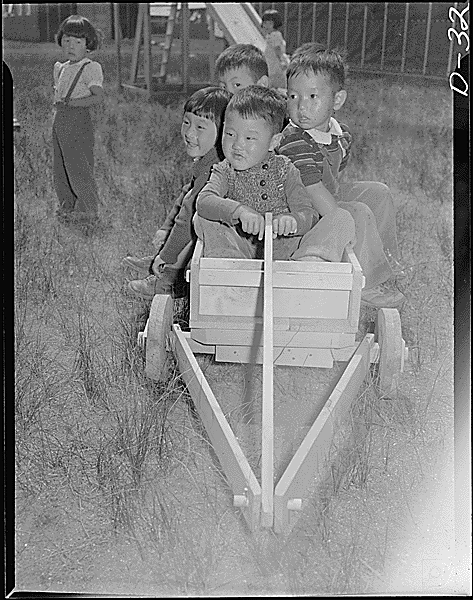
homemade scrapwood wagon at Tule Lake Relocation Center, img: Nat'l Archives rec. no 210-G-D32
07/01/1942, 70 years ago this week. That's when this photo was taken.
I've been taking these things as I stumbled across them, one, two, or three photos at a time. But last winter, I decided I needed to dig in, so I went through the National Archives to find as many images as I could that depicted the life inside the WWII-era interment camps for Japanese American kids.
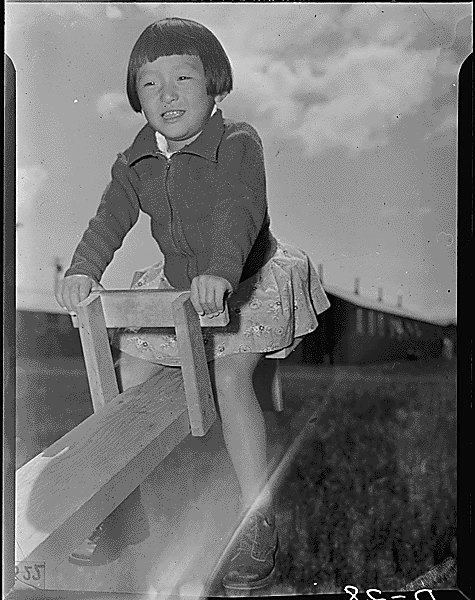
Maye Ikemoto on scrapwood seesaw, Tule Lake, NA rec no. 201-G-D28
These families lost everything when they were forcibly removed from their homes, farms and businesses. Then they were imprisoned in camps the middle of BF Nowhere with nothing but tarpaper barracks and scrapwood. Which they used to construct some semblance of normal American childhood for their kids.
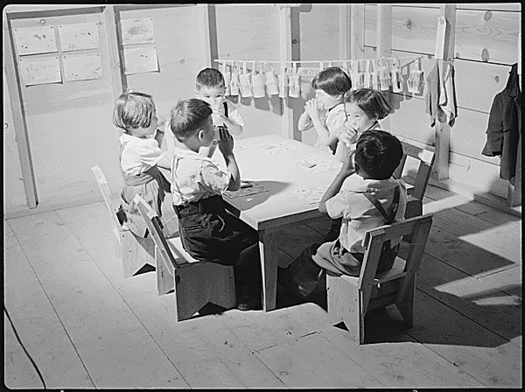
09/07/1942: "Nursery school children pause for refreshments of graham crackers and milk," Tule Lake, NA rec no. 210-G-D154 [note: the Archives has the captions switched with the photo below.]
I admit, it's an unconventional angle from which to view the internment experience, but I am fascinated by the things these people made for their kids. The combination of design, ingenuity, utility and materials, all in this crazy context of racist wartime paranoia and injustice, all mobilized to enrich and protect kids, it just blows my mind.
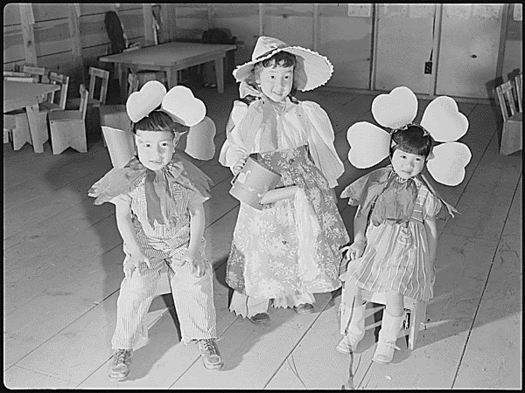
"Three little nursery school children in costumers for the Labor Day parade," Tule Lake, Rec. no. 210-G-D153
Six months ago it was just half a mind, but now I'm about 2/3 convinced that I need to remake a bunch of this stuff and get it out there somehow, as a history, a how-to manual, an exhibit, something. And do it while these kids, some of the last survivors of the camps, are still with us.
[An admin note: when I pulled these photos from the National Archives last winter, there was no way to link to the originals; hell, the search results would time out and disappear in like 20 minutes, before I could even see them all. Total PITA. Which is why I left the Archives local record number in each image file name. Now, though, whoa, there is instant search, and simple, permanent URLs and tags for each image, which is awesome. They all use the other record number, the one I didn't keep, so I've gone in and re-searched and linked each one by hand, but hey. God Bless America and her archivists' well-executed IT initiatives.
Meanwhile, the Japanese American Relocation Digital Archive has already gathered over 1,000 images from the War Relocation Authority and other sources for their skillful historical interpretation.]
Anyway, I'll try to put these in some order. here are more from 09/07/1942, the "clever costumes" made for the Labor Day parade. Mary Mary quite contrary and her flowers:
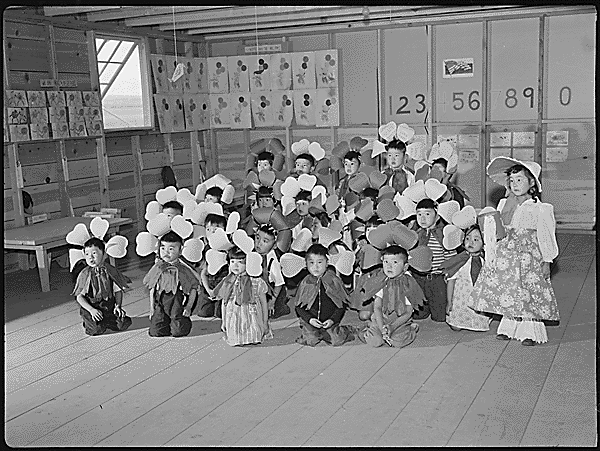
record no: 210-G-D157
"Little Bobby" made his flower headdress from painted cereal boxes:
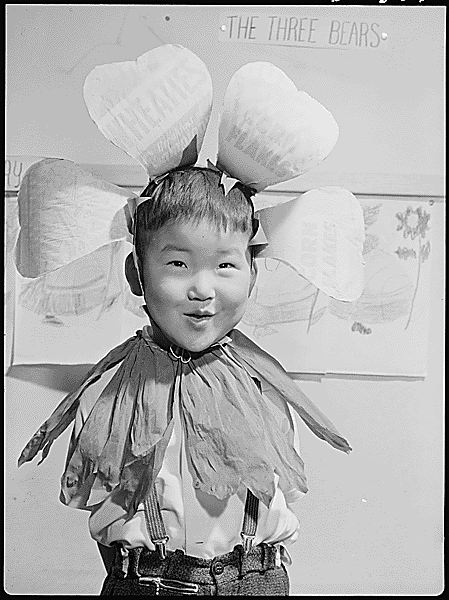
rec. no.: 210-G-D151
"Drawing time": I think those are trees behind them. The caption says 09/08, but the calendar looks like the 9th or 10th to me. Also, the Archives has all these images from Tule Lake credited to Francis Stewart, the staff photographer who traveled around documenting the camps for the War Relocation Authority.

rec. no.: 210-G-D152
"Art time in the nursery school." You know what did it to me, don't you? Those chairs. They are killing it. I know I first found similar chairs in photos of Topaz, and obviously, WTF, right? but I'd start making Tule Lake Chairs tomorrow.
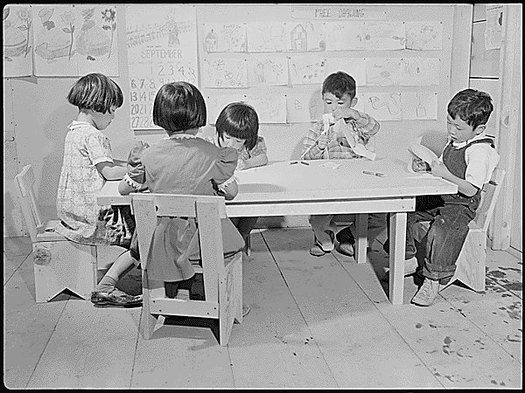
rec. no. 210-G-D155
"Nursery school children taking a mid-afternoon nap" on WRA-issue cots:

rec. no.:210-G-D156
These are from Stewart, and dated 11/02/1942. There's the cot, there's a fiberboard playhouse, and some toys. Is that dog made from paper?
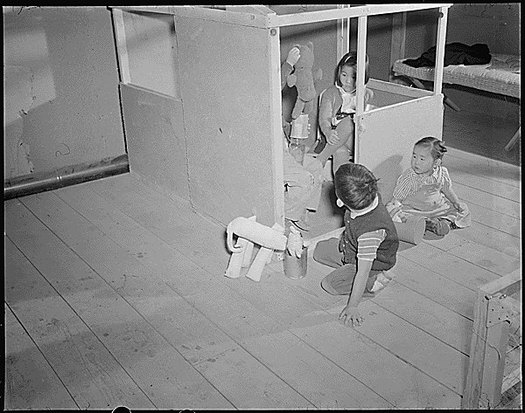
rec. no.: 201-G-A615
"Home made toilets for nursery school children." They are literally pots. With lids. And wooden seats.

Rec. No.: 210-G-A616
"Twinkle Twinkle little star." And those chairs.
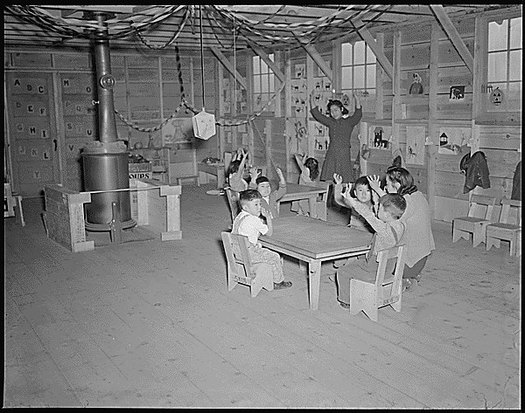
Rec. No.: 210-G-A617
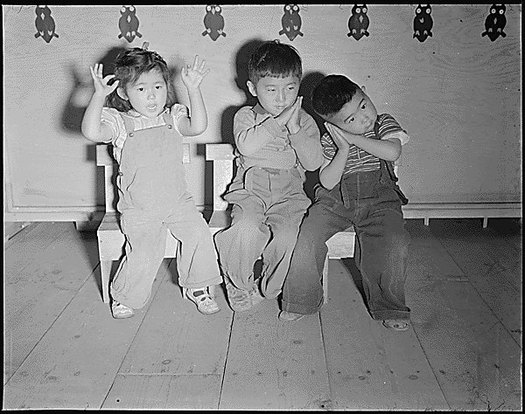
Rec. No.: 210-G-A618
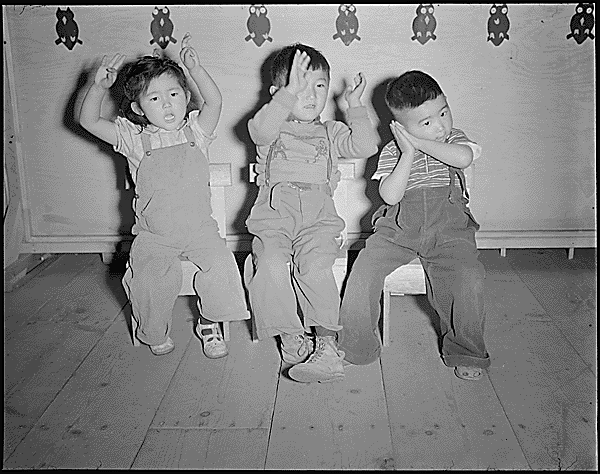
Rec. No.: 210-G-A619
Older kids, from 02/02/1943, I think this is a 2nd & 3rd grade "Activities Class" at Tule Lake. Only the kids who conceived and executed the mural are mentioned in the caption, but the boys at the plywood tables look like they've assembled those doll beds? It's very neat for an activities class:

Rec. No.: 210-G-B267
The same scene, with an easel. Looks like that girl on the right made an American flag for her activity:

Rec. No.: 210-G-B269
Oh, man. These three stroller shots are from Stewart's earlier trip in September 1942, and all share the same caption: "This picture of an evacuee child was taken for evacuee use. This picture is interesting from a documentary angle, however, for it shows the doll-like features of the Japanese children."
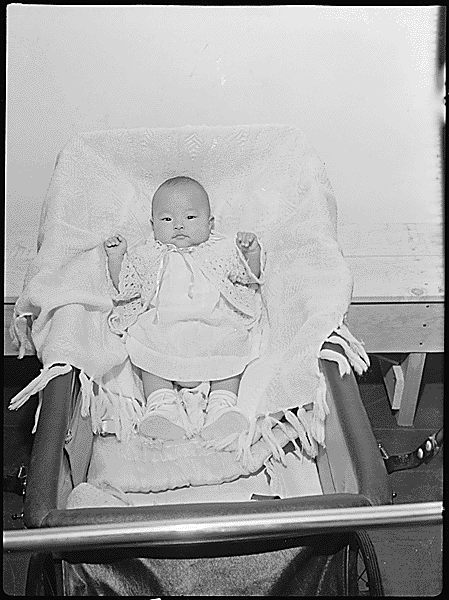
local identifier: 210-G-D270
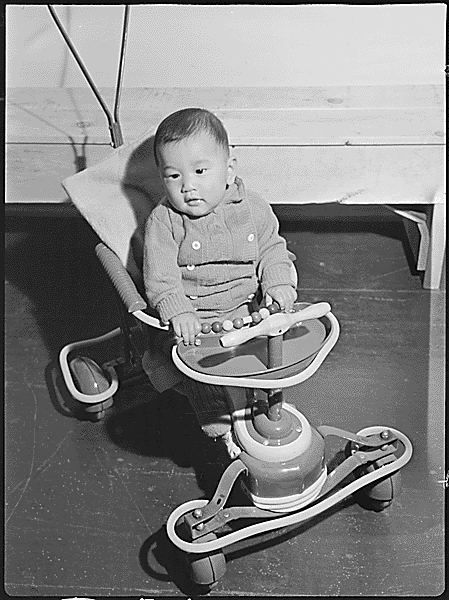
local identifier: 210-G-D265

local identifier: 210-G-D254
"This picture of Japanese children was taken for evacuee use, however it is interesting from a documentary angle."
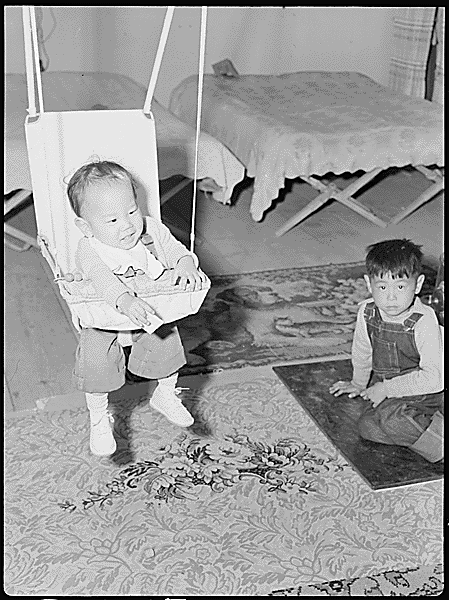
local identifier: 210-G-D255
Really, it's not the need to justify the photo "from a documentary angle" so much as the phrase itself, "taken for evacuee use," which reminds you that the rest of these photos were not taken for internees, but of them, and for the government which was interning them.

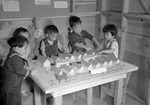
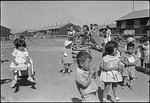



really really incredible. thank you for sharing your findings.
Amazing, gutting photos.
The Labor Day parade pictures are particularly heartwrenching. Taken just about the time that FDR stood in front of the White House Christmas tree and, when asked how he could be so cheerful, said "let the children have their moment of laughter"--this going on in the same country. A terrible moment in time. Gosh I hope those children grew up and had happy lives.
My mom was born in Tule Lake in fall 1945. In the spring of 1943, the WRA made internees fill out a loyalty questionnaire with the infamous questions 27 and 28. "No" answers on these deemed one disloyal and those who answered such were relocated to the newly designated Tule Lake Segregation Center, chosen as the site for the segregation of "disloyals" and "no-no boys" because of the high number of residents who had answered thusly. It looks like all these photos are from before segregation. My mom was born while all camps except Tule Lake were being closed after the end of the war; Tule Lake wasn't closed until March 1946.
Thank you for posting these (and the earlier ones you posted), Greg. And for including the captions/commentary (and your commentary on them). The comment about "doll-like features" of the babies really f's me up--as well as the fact that they're still identified solely as "Japanese," despite the fact that, because these photos are all of children, there is no denying or obfuscating, through language and euphemism like "alien and non-alien" (meaning the Issei forbidden by law from naturalizing and their American-citizens-by-birth children), that these are American citizens born on American soil.
I don't know if you're familiar with the book and Smithsonian exhibit The Art of Gaman, which focuses on the handicrafts made by Japanese Americans while imprisoned in American concentration camps. I don't know how many of the items in the book and exhibit are child-related, but I think it'd be of interest to you.
Book:
http://www.amazon.com/The-Art-Gaman-Internment-1942-1946/dp/1580086896
Exhibit:
http://americanart.si.edu/exhibitions/archive/2010/gaman/
Exhibit slideshow:
http://americanart.si.edu/exhibitions/online/gaman/index.cfm
Thanks for adding your and your mom's experience, I saw that gaman show, and I think there was a chair like these, but adult size. There was also a lot of smaller, finer woodworking, things like boxes and cabinets, maybe a side table, etc. There were actual craftsmen swept up into the camps, too, so it wasn't all just a matter of making do.
But the show was also very much about the kinds of objects that families kept, rare mementos of the camp experience, whereas a lot of the stuff in these photo was probably, rightly, considered junk to be left behind and forgotten. Even more so because they were for kids, not for adults.
Literally every time I think about it, it just blows my mind that the American government was putting American children my parents' age in prison camps in the middle of the desert. No gaman for me.
FYI: NY Times: At Internment Camp, Japanese American Pilgrims Explore Choices Of The Past